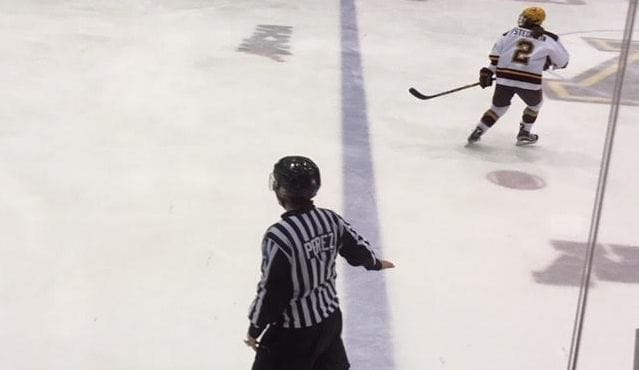Linesman Night
Immediately at the beginning of the game, the radio host started talking about wondering if it was going to be "linesman night" again at the Broadmoore World Arena.

Introduction
A couple of weekends ago, on October 31, I was watching the NCHC conference game Colorado College v. North Dakota. It was kind of a wonky setup, since I was watching it over a web feed, but the audio was provided via a feed from Colorado College's local radio station (i.e. it was a radio broadcast; there was no actual audio directly accompanying the video provided by on the web feed). [1]
Immediately at the beginning of the game, the radio host started talking about wondering if it was going to be "linesman night" again at the Broadmoore World Arena. When the announcer introduced the two linesmen, he stated that they "felt it necessary to toss just about everybody out of the faceoff circle last night." The announcer claimed that on Friday night, the linesmen ejected something like 50 centers from faceoffs. A supervisor of officials once told me that, in any hockey game, there's a stoppage of play, on average, once per minute of play. This means that, given 60 minutes in regulation play for a college hockey game, one would expect around 60 faceoffs for that same timeframe. Thus, if it's true that 50 centers were ejected from the faceoffs on Friday night, roughly 5/6 faceoffs, or 83.3% of faceoffs in the game, saw the linesmen throwing players out of the faceoff.
Obviously, this is a pretty high number of faceoffs to have this kind of exceptional action happen [2]. On Saturday night, it seemed that the announcers and spectators were pretty geared up for the same thing to happen again, as was instanced by the radio announcer complaining every time a center was "chased from the faceoff circle."[3] While I originally was complaining about the commentating (as can be attested by my wife), I thought about this for a while, and I realized that the average person watching a hockey game probably doesn't know why a center is ejected from the faceoff circle.
Official Rule on Faceoffs

This rule[4] essentially says that there are three ways for a center to get ejected from the faceoff:
- Taking too long to make a line change
- Making physical contact with an opposing player prior to the puck dropping
- Encroachment/Movement During the Faceoff (NCAA)
Excessive Time Taken for Line Change
After a stoppage of play, the back referee (the one furthest from where play stopped) will conduct the line change procedure. Since the home team gets last change privilege, the referee will signal to the visiting bench that they have 5-8 seconds to change players. When this 5-8 seconds has expired, the referee will raise his hand to indicate that the visiting team's line change has completed and the home team now has 5-8 seconds to complete their line change.
If a team attempts to change players after their line change period has ended, the referee will send the player(s) back to the bench, as they are ineligible to be on the ice until after the puck drops. In this case, there is a delay to the game caused by one of the teams not abiding by the referee's signals on line changes, and their respective center(s) will be ejected from the faceoff circle.
This happens pretty rarely, actually, and is usually obvious, as there will be some amount of communication between the referee conducting the line change and the bench, and possibly players coming from off the ice to go back to the bench.
Illegal Contact
If any player makes contact with another player (usually the player on the opposing side of the faceoff in the same position) prior to the faceoff, the linesman will signal that player's center should be removed from the faceoff. If the wings behind the linesman dropping the puck are the ones committing the infraction, the linesman not dropping the puck will give this signal.
While this does, occasionally, happen with a player that's not taking the faceoff (i.e. the center), usually this happens when one of the centers "jumps" the faceoff, meaning they mis-anticipate the linesman dropping the puck, and make stick contact too early. Again, this is usually an obvious situation to see, because there will be movement prior to the dropping of the puck (it's kind of like a false start in football).
Encroachment/Movement During the Faceoff
This is the most common thing that causes players to be ejected from the faceoff circle, as well as probably the hardest to understand for spectators. The essential point is that players have the responsibility to be in position and (in NCAA hockey) stationary at the conclusion of the line change procedure[5]. This means, if they are taking the faceoff (i.e. playing the role of center), they must be facing each other, with hips and shoulders squared off, and sticks on the ice, touching the white half-moon shapes on either side of the faceoff dot. All other players who are not taking the faceoff must have their skates outside of the faceoff circle, not be in contact with the opposing player playing their respective position, and not be moving.
If a player enters the faceoff circle early (again, "jumping" the draw), the linesman will eject the center and signal for a replacement. If one or more players on a team don't get into the correct position, their respective center will be ejected.
It's important to note that this doesn't usually happen in a bubble - the linesman is talking with the players (usually something akin to "White - back up", "green - on side", etc...). We, as spectators, typically can't hear this, though, so, to us it seems as though the linesman just stands up and decides to eject a center.
Why does this matter?
If you've watched hockey as much as I have, you probably wonder why this even matters. What difference does it make if a player jumps the faceoff a little bit, or if a winger is a little too close to the official dropping the puck?
It's the job of an official to be an impartial arbiter of the game. When play stops (for whatever reason), the officials' responsibility is to get the puck back into play fairly, safely, and quickly. When an official drops the puck for a faceoff, it's unlikely he/she can get the perfect faceoff. However, he/she can try to make it as fair as possible by not allowing players who are obviously cheating to gain a competitive advantage.
But, there's another reason this matters. Of the two linesmen on the ice in a 1 referee-2 linesmen (three-official system) or 2 referees-2 linesmen (four official system), when the puck is dropped, one linesman is responsible for dropping the puck and ensuring the players he/she can see (read: "in front of him/her") are in position. The other linesman is responsible for the players he/she can't see (the ones behind the linesman dropping the puck). If the players behind the linesman dropping the puck encroach on the play before the puck drops, this is an easy way for the linesman dropping the puck to get injured as he/she retreats from the circle after the faceoff. In fact, in non-professional settings (youth, high school, college, juniors, etc...) this is one of the most common ways a linesman is injured.

Conclusion
You now know what will trigger an ejection from a faceoff circle: long line changes, illegal contact, and encroachment/movement. Of these, encroachment is typically the reason the ejection occurs. It's important for linesmen to enforce this rule, since it helps prevent injury, but also it is conducive to the overall flow of the game (if the faceoffs are unfair, what else is being overlooked during the game?). One of the linesmen was injured during the October 31st game, and didn't come back to the ice after the 2nd period break[6].
Passions run high during a hockey game. Even commentators are susceptible to it, even though they should be more aware of the rules of the game and why infractions occur. Rather than complaining about it on-air, it's probably better to explain to the listeners why something is happening, or at least, your interpretation of it. Noone is there to see the referees and linesmen do their job, but if they do it incorrectly or unfairly, they are the most visible and, sometimes, talked about.
The title image shows a good friend of mine, Ricky Perez (a phenomenal official whom I attempt to emulate every chance I get) working as a linesman for a series at Minnesota. He graciously sent me pictures to use for this post, for which I am extremely grateful. ↩︎
I should say that I didn't actually see Friday night's game, so I can't comment on whether the number of centers tossed was accurate. ↩︎
There were ~28 centers that were ejected from a faceoff on Saturday night, which was slightly closer to the average I would expect, which is around 20%, or 12 total centers ejected. ↩︎
2014-16 NCAA Men's and Women's Ice Hockey Rules and Interpretations. (2014) (1st ed., pp. 65-66). Indianapolis. Retrieved from http://www.ncaapublications.com/p-4363-2014-15-and-2015-16-ice-hockey-rules-and-interpretations-due-late-fall-2014.aspx ↩︎
In the USAHockey rulebook, players need not be stationary. They can be moving, provided they are onside (i.e. the required distance from the faceoff). NFHS (National Federation of High Schools) was originally like the USAHockey rulebook, but changed this rule in 2017 to be more like the NCAA rule in that players must be stationary before the faceoff. ↩︎
This is somewhat interesting in its own right, since the 3rd period of the game was played using what's known as the "2-1 system" (2 referees/1 linesman). This is what the Minnesota High School Hockey League uses for most regular season games, so that was interesting to watch. ↩︎
